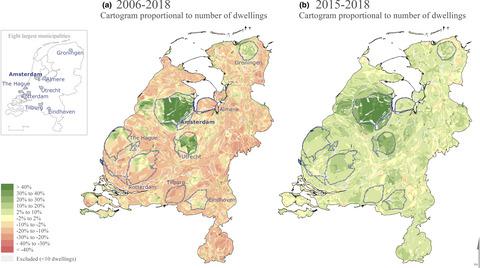当前位置:
X-MOL 学术
›
Trans. Instit. Br. Geogr.
›
论文详情
Our official English website, www.x-mol.net, welcomes your
feedback! (Note: you will need to create a separate account there.)
Spatial housing market polarisation: National and urban dynamics of diverging house values
Transactions of the Institute of British Geographers ( IF 3.3 ) Pub Date : 2019-11-01 , DOI: 10.1111/tran.12346 Cody Hochstenbach 1 , Rowan Arundel 1
Transactions of the Institute of British Geographers ( IF 3.3 ) Pub Date : 2019-11-01 , DOI: 10.1111/tran.12346 Cody Hochstenbach 1 , Rowan Arundel 1
Affiliation

|
Housing is central in the reproduction of social inequalities. Beyond divides across populations, trends point to increasingly unequal housing‐market dynamics across space. Nonetheless, little systematic evidence exists on the spatial inequality of housing values. In this paper we address this through a detailed investigation of house‐value developments in the Netherlands over time and space. We draw on national registers including longitudinal and geocoded data for the entire housing stock over the 2006–2018 period. Spatial polarisation is examined across different scales at the national, provincial, and urban level. We further investigate how housing‐market inequality trends vary over time, particularly between periods of economic boom and house‐price increases or, conversely, periods of downturn. Our analyses expose a substantial and widespread trend of spatial polarisation. Rising spatial inequality between neighbourhoods is clearly apparent at the national level, within all but one province, as well as for 44 of the 50 largest municipalities. The polarising trend appears structural and pervasive. While boom periods saw the strongest increases, inequality levels, remarkably, remained stable or even saw continued increases over the period of declining house prices. These patterns of spatial polarisation in house values have fundamental societal implications towards uneven wealth accumulation and in amplifying socio‐economic cleavages across populations and space.
中文翻译:

空间住房市场两极分化:房屋价值差异的国家和城市动态
住房在社会不平等的再现中起着中心作用。除了人群之间的鸿沟外,趋势还表明跨空间的住房市场动态越来越不平等。但是,关于住房价值空间不平等的系统证据很少。在本文中,我们通过对荷兰房屋价值随时间和空间发展的详细调查来解决此问题。我们利用了国家登记册,其中包括2006-2018年期间整个房屋存量的纵向和地理编码数据。在国家,省和城市级别的不同规模上检查了空间极化。我们将进一步研究住房市场不平等趋势如何随时间变化,尤其是在经济繁荣时期和房价上涨时期(或相反)之间。我们的分析揭示了空间极化的实质性和广泛趋势。在全国范围内,除了一个省以外,以及在50个最大的城市中有44个,社区之间的空间不平等现象日益明显。极化趋势呈现出结构性和普遍性。繁荣时期增长最为强劲,但不平等水平在房价下跌期间保持稳定甚至持续增长。房屋价值的这些空间极化模式对不均衡的财富积累以及扩大人口和空间之间的社会经济分裂具有根本的社会意义。以及50个最大城市中的44个。极化趋势呈现出结构性和普遍性。繁荣时期增长最为强劲,但不平等水平在房价下跌期间保持稳定甚至持续增长。房屋价值的这些空间极化模式对不均衡的财富积累和扩大人口与空间之间的社会经济分裂具有根本的社会意义。以及50个最大城市中的44个。极化趋势呈现出结构性和普遍性。繁荣时期增长最为强劲,但不平等水平在房价下跌期间保持稳定甚至持续增长。房屋价值的这些空间极化模式对不均衡的财富积累以及扩大人口和空间之间的社会经济分裂具有根本的社会意义。
更新日期:2019-11-01
中文翻译:

空间住房市场两极分化:房屋价值差异的国家和城市动态
住房在社会不平等的再现中起着中心作用。除了人群之间的鸿沟外,趋势还表明跨空间的住房市场动态越来越不平等。但是,关于住房价值空间不平等的系统证据很少。在本文中,我们通过对荷兰房屋价值随时间和空间发展的详细调查来解决此问题。我们利用了国家登记册,其中包括2006-2018年期间整个房屋存量的纵向和地理编码数据。在国家,省和城市级别的不同规模上检查了空间极化。我们将进一步研究住房市场不平等趋势如何随时间变化,尤其是在经济繁荣时期和房价上涨时期(或相反)之间。我们的分析揭示了空间极化的实质性和广泛趋势。在全国范围内,除了一个省以外,以及在50个最大的城市中有44个,社区之间的空间不平等现象日益明显。极化趋势呈现出结构性和普遍性。繁荣时期增长最为强劲,但不平等水平在房价下跌期间保持稳定甚至持续增长。房屋价值的这些空间极化模式对不均衡的财富积累以及扩大人口和空间之间的社会经济分裂具有根本的社会意义。以及50个最大城市中的44个。极化趋势呈现出结构性和普遍性。繁荣时期增长最为强劲,但不平等水平在房价下跌期间保持稳定甚至持续增长。房屋价值的这些空间极化模式对不均衡的财富积累和扩大人口与空间之间的社会经济分裂具有根本的社会意义。以及50个最大城市中的44个。极化趋势呈现出结构性和普遍性。繁荣时期增长最为强劲,但不平等水平在房价下跌期间保持稳定甚至持续增长。房屋价值的这些空间极化模式对不均衡的财富积累以及扩大人口和空间之间的社会经济分裂具有根本的社会意义。











































 京公网安备 11010802027423号
京公网安备 11010802027423号